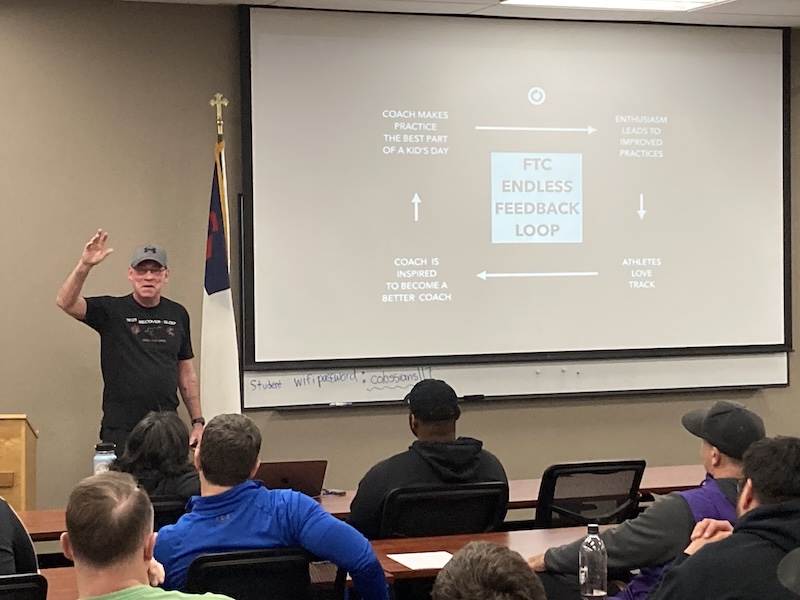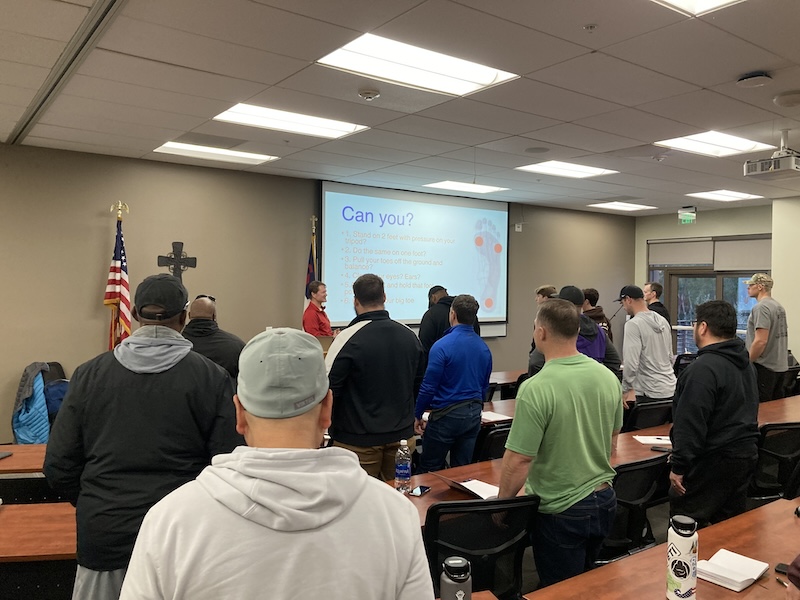
“When it’s your time to make a difference in a kid’s life, are you going to be courageous enough to do it?”
During his opening presentation for Feed The Cats Southern California at Crean Lutheran High School, just up the road from The Great Park in Irvine, Tony Holler challenged the attendees to consider this simple question. In that moment, on the big screen Holler replayed an iconic clip of Portland Trailblazers Coach Mo Cheeks stepping in to help a young singer get back on track after she stumbled over the words in the National Anthem, providing her just enough support so that she could right herself and carry the song through to a rousing finish.
Not all coaching moments will have that public or profound of an impact, but as self-professed essentialist, Holler’s point cuts to the core of coaching: are you willing to make a difference?
Not all coaching moments will have that public or profound of an impact, but as self-professed essentialist, @pntrack’s point cuts to the core of coaching: are you willing to make a difference? Share on XEasy enough, right? But it’s not—because a difference is, by definition, not the same. The same is easy—it’s known, it’s repeatable, it’s low-risk. Across 14 presentations and two days, Tony Holler, Chris Korfist, and JT Ayers took different angles on that essential question: given the chance, are you going to do what it takes to make a difference in a kid’s life?
Though the audience was largely a three-way split amongst track coaches, football coaches, and S&C coaches, Holler and Korfist delivered a range of insights that apply equally to coaches in any sport. More importantly, those points were ones that might not get made in sport-specific seminars—as in, not the same.
Been to a softball coaching clinic? Just show us new infield and outfield drills, my kids are bored to tears with all of mine!
Been to a soccer coaching course? Just show us which formation to play so we can stop getting hammered in the midfield!
When the time comes, here are three takeaways from Holler and Korfist to make difference.
1. Start with Joy

When crafting his core principles, Holler says he wanted to create value statements he considered broadly inarguable—who would oppose or vigorously dispute “make practice the best part of a kid’s day”? And yet, day-in and day-out on the field, this simple notion is tacitly challenged by coaches whose practices are, in design and execution, entirely joy-less and a part of the day that the players grind through.
For youth sport coaches, whose athletes are coming to training from a long day of school and likely looking at a pile of homework to finish when they leave, more work is not the best value you can offer for their crunched time.
Start with joy.
Why not? Well, happiness is hard. It takes risk. It takes opening yourself up to judgment. It takes trying new and different things, some of which completely flop—and if you coach groups of teenage girls like I do, you know they have a sharp side-eye for adult missteps, flaws, and failures.
You can do the same warm-up, the same conditioning, the same drills and you won’t risk judgment for it because, hey, it may be miserable and boring but it’s the same, we’ve been doing it forever and will not outwardly fail.
But the days when you walk off the training ground and your athletes are sweating and breathing hard with that live bounding electricity in their eyes and exclaiming to each other “that was fun,” you know you are on to something. Instead of having players who find excuses to miss your practices, you’ll have players who will make excuses to miss other commitments in order to make your practices.
When it’s your time to make a difference in a kid’s life, are you going to be courageous enough to do it?
My 17-year-old is a two-sport varsity athlete and across the past four club/travel/high school seasons of soccer and softball she has played for nine head soccer coaches and five head softball coaches and in some of those seasons, the phrase “that was fun” has not only never been spoken…I doubt it ever crossed the players’ minds.
Because it never crossed the coach’s mind either—that this is a game, these are kids, and it should be fun.

Holler’s “FTC Endless Feedback Loop” is another simple and self-evident reality that longtime sport coaches will recognize as a truth…but may need a jolt and spark to initiate in their own settings.
What happens when you make practice the best part of a kid’s day? They are happy and excited. What happens when your players are happy and excited? You as a coach are inspired to do the best coaching job you can to turn that energy and motivation into success. What happens when you as a coach are inspired to bring your A-game every training session? Your players are happy and excited…and so it goes.
And, equally, the opposite is true.
When a coach loses sight of joy, the kids start looking at the calendar and playing out the string. And once the kids are just riding out the season, then the coach is just riding it out. Which, if you’ve been there—can’t this season just end, already?—tends to be miserable all around.
“I think joy creates winning,” Holler said. “I don’t think misery does.”
2. Where the Rubber Meets the Road Is More than a Business Cliché

Whether loading for a swing or planting for a shot, with both my softball and soccer players I frequently cue “force comes from the ground up” and in those moments I’m generally speaking to intent—to deliver force you have to want to drive off of something.
Okay, super—so now what exactly does that interaction between the studs of a cleat and the turf or dirt actually look like, and how can you better train the foot to execute that critical athletic function?
Yep, got me there.
And not just me—former Air Force star quarterback Beau Morgan attended the seminar with a pair of his former teammates, and as I was chatting with him he readily whipped off a shoe to show a wrecked foot. Morgan mentioned how if he’d had a coach who understood how to train the feet when he was younger, he would have had an even better high school track career and then the cup of coffee he had with the Cowboys in the NFL may have been more than just that quick hot sip.

Korfist discussed how to put pressure on “the tripod” of the foot and, even more interestingly, how the foot would find a different (and less effective) tripod if the full foot wasn’t consistently accessed. Where the foot becomes a fulcrum in acceleration, how the fastest athletes tend to land slightly open-footed on the outside of their foot, and ways he trains foot positioning with slant board jumps and prime times were thought-provoking points that apply across all sports.
“Whatever your foot doesn’t do, the rest of your body will do.”
Visualize that for a moment. For softball coaches, volleyball coaches, and basketball coaches, how often have you heard a player described as having “bad feet” as a catchall phrase for the fact that they just don’t look very athletic when executing certain skills?
Whatever your foot doesn’t do, the rest of your body will do, says @korfist. Share on XThe rest of their body is trying to do something their feet need to be trained to do first. One of Korfist’s entire slides was nothing more than a black and white quote from Swiss physiotherapist and researcher Romain Tourillon:
-
“Many practitioners understand that the human foot complex is the underestimated link of the kinetic chain, and can be the limiting factor in explosive tasks such as sprinting, cutting, or jumping.”
Video 1. Chris Korfist demonstrates wall drills he performs with his athletes to improve the quality and direction of force from the ground.
3. Ask Yourself: Are We Practicing What We Want to Get Better At?

Describing early-season training with his sprint group, Korfist noted that they had been beginning every session on the wall working on foot progressions, knee drive, and other keys to improving speed—in some cases, spending the better part of the session on these movements.
Joy does not have to look like recess—learning and mastering something new and challenging that makes them better at the sport they care about is one of the ways your best athletes have fun.
This was what Korfist wants his athletes to get better at, so he makes it a focus of his training—for coaches in all sports, there’s that basic question: are you practicing what you want to get better at?
A couple years ago, when I was taking the US Soccer C-License course, as an icebreaker the instructor asked us to go around the room and say why we were there in the first place. One of the sharpest coaches in the group, Jake, said that he’d signed up because he’d hit a point where he knew he could roll up any time, any place, and execute a perfectly adequate training session. Needed no planning or effort, maybe jot a note or two on a Post-It, maybe just wing it, didn’t matter—he could lead players through 90 minutes that looked, felt, and functioned like a practice.
Except, he realized those rote sessions weren’t accomplishing anything but clocking time—so he was there to learn new ways to be purposeful and design training sessions that matched how he wanted his team to play in games.
Similar to Korfist, Holler gears his training to the qualities he wants his athletes to be good at. Not surprisingly, he keeps that simple:
- Sprint Fast
- Jump High/Jump Far
- Lift Heavy
- Bounce
Video 2. Tony Holler showing a few of the “X-Factor” workouts his athletes do to jump high, jump far, and bounce.
As a coach, looking at your training sessions, you can ask yourself if you’re getting better at what you want to get better at or if you’re just getting better at knocking out the same, seamless 90 minutes on the field.
And, then, you can ask yourself again: When it’s your time to make a difference in a kid’s life, are you going to be courageous enough to do it?
Since you’re here…
…we have a small favor to ask. More people are reading SimpliFaster than ever, and each week we bring you compelling content from coaches, sport scientists, and physiotherapists who are devoted to building better athletes. Please take a moment to share the articles on social media, engage the authors with questions and comments below, and link to articles when appropriate if you have a blog or participate on forums of related topics. — SF

